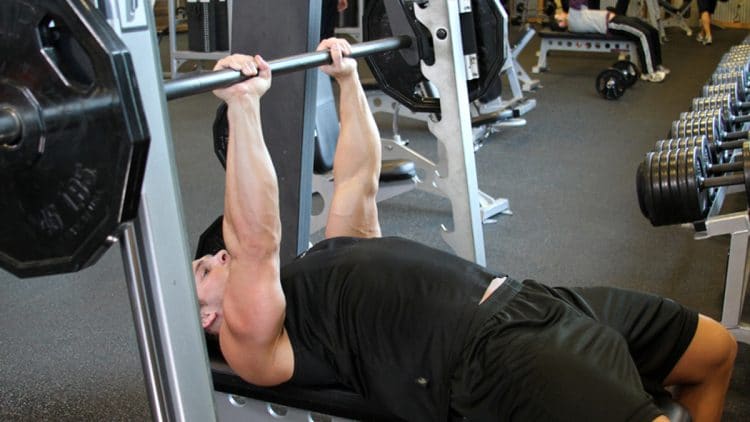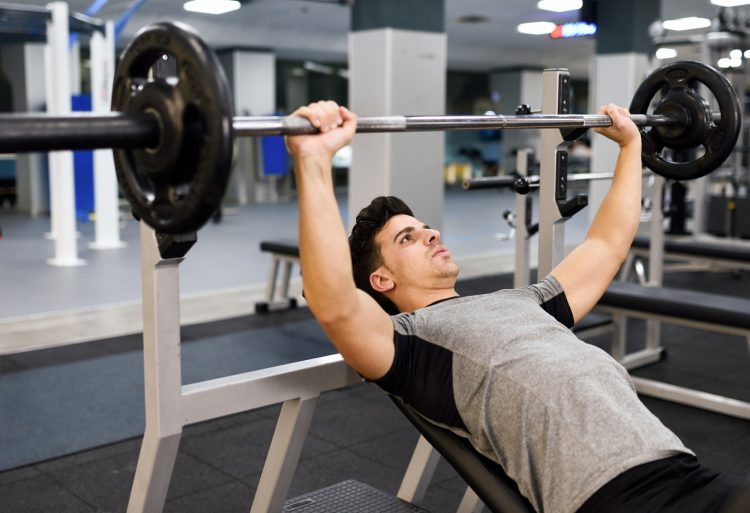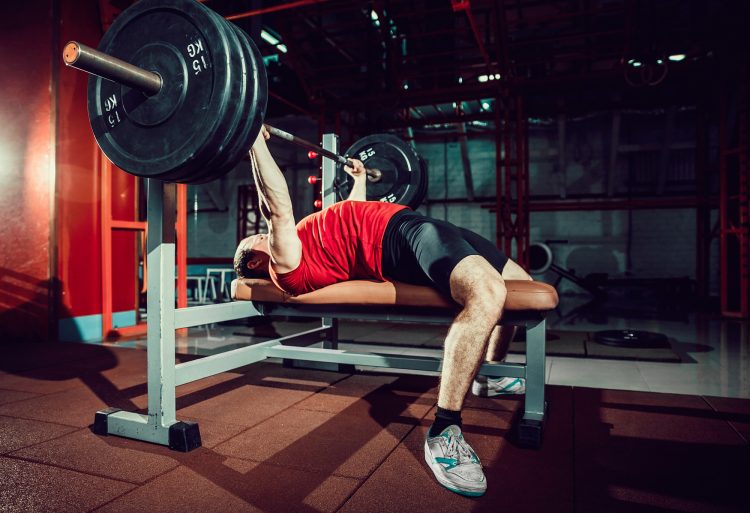The bench press is one of the most effective tests for upper body strength. It is also one of the three big lifts in powerlifting besides squats and deadlifts.
Although performing a bench press might look relatively simple, it involves several nuances.
With over seven years as a personal trainer, I’ve seen two kinds of bench pressers: those who consistently hit PRs and those who struggle to progress. The strength and muscle plateau ultimately boils down to five mistakes the second group makes.
These mistakes don’t only stall progress, but they can also lead to a loss of motivation and increase the risk of injury.
The good news is that these five mistakes are curable, and the benefits of fixing them are instant. So, without any further ado, here are the five mistakes you must stay clear of to promote chest hypertrophy and build upper body strength:
Mistake 1: Not Pausing Your Reps
Level Up Your Fitness: Join our 💪 strong community in Fitness Volt Newsletter. Get daily inspiration, expert-backed workouts, nutrition tips, the latest in strength sports, and the support you need to reach your goals. Subscribe for free!
In my opinion, not pausing the reps at the bottom of the range of motion (ROM) is the biggest bench press mistake lifters make, especially when building strength is the main objective.
Some lifters reverse the movement when the bar is a few inches off their chest, whereas others bounce the bar off their chest like a basketball. Both these techniques are incorrect. The former limits chest fiber stimulation, while the latter significantly increases injury risk.
But why do people make these mistakes, you ask?
Bouncing the bar off the chest adds momentum, which can help lift heavier weights. Plus, faster reps decrease the muscle’s time under tension (TUT), making the exercise inherently easier. On the other hand, a partial ROM makes the exercise less challenging.
To build a stronger barrel chest, you must pause at the bottom of the range of motion. Here is why:
Teaches Full Body Tension
When you pause at the bottom during a bench press, you have no choice but to brace your whole body. Letting your body lose can cause imbalance, hampering your power output.
Incorporates Leg Drive
The bouncing the bar off the chest technique involves fast eccentrics and concentrics. You don’t have enough time to engage your lower body when using this method. Conversely, pausing the bar on the chest allows you to build full body tension and recruit leg drive to power the bar off the chest.
Trust me; the bar will fly off your chest when you start incorporating leg drive on the bench press.
Fixes the Line of Pull
Ricocheting the bar off the chest can throw your movement mechanics for a toss and cause the barbell to wobble with each rep. Pausing at the bottom with each rep allows you to find that perfect line of pull every time.
How To Incorporate Paused Reps Into
Make no mistake; pausing the bar on the chest is not easy. The added time under tension can make the exercise more challenging. Here is how to add this technique into your training regimen without feeling overwhelmed:
- Start with a Light Load: If you’ve never tried paused reps, start with 50 percent of your one-rep max. This is even more important if you train without a spotter. Hold the bar at the bottom for longer if the bar feels too light.
- Consider a Partial Pause: Paused reps can be intimidating. Beginners can start by pausing the bar a few inches off the chest for the recommended time before initiating the pushing phase.
- Build Over Time: The best part about paused reps is that you don’t have to do them in every set. Incorporate paused reps in the first two working sets, then switch to conventional bench presses for the remaining sets. Thanks to central nervous system (CNS) adaptations, you will experience similar contractions on the regular sets as well.
Paused reps are even more important for powerlifters. Powerlifting rules require that the barbell comes to a complete halt at the bottom of the ROM. Paused reps are the way to go in this case.
Pro Tip: The pause at the bottom doesn’t have to be too long. You can start with a 1-second pause and add to it as you get stronger.
Mistake 2: Neglecting Variations and Accessory Work
The flat barbell bench press is a staple in most chest training routines.
It is usually the first exercise a lifter performs on chest day. However, performing three sets of 8-15 reps of the same exercise in each session can lead to plateaus. You must consistently vary your workouts to keep your muscles guessing and make consistent strength and muscle gains.
Exercise variations help you train the same muscle group but from a unique angle or using a different movement pattern.
This slight change in form is generally enough to ignite new growth.
Although powerlifters must perform the bench press, they can ensure constant progress by incorporating accessory exercises into their training.
A stagnant bench press could be caused by a weak supporting muscle group. Accessory exercises and variations can be incredibly effective in addressing these issues.
Related: 6 Powerlifting Strength Training Programs – Beginner to Advanced
Barbell Bench Press Variations To Target Specific Weaknesses
Your bench press is as strong as the weakest link. Here are some variations that you must add to your exercise arsenal:
Close-Grip Bench Press (Weak Triceps)
This exercise involves grabbing the barbell with a chest-width grip and keeping the elbows tight to the torso throughout the ROM. The close-grip bench press biases the triceps, which can translate to a stronger conventional bench press.
Incline Dumbbell Bench Press (Upper Chest Recruitment)
The upper chest is a lagging muscle group for most people. Using dumbbells allows you to pull the dumbbells below the ribcage at the bottom, leading to greater upper chest stimulation. It also leads to greater anterior delt activation, leading to better performance on the standard bench press.
Floor Press (Lockout Power)
To register a rep in a powerlifting comp, you must lock out your elbows at the top. However, many people struggle with fully extending their elbows on the bench press. Since the floor press involves a limited range of motion, you can focus on the lockouts.
Here are the 10 other bench press variations and accessory movements:
- Machine Chest Press
- Decline Bench Press
- Wide-Grip Bench Press
- Board Press
- Spoto Press
- Dumbbell Floor Flyes
- Dumbbell Pullovers
- Push-Up Variations
- Cable Flyes
- Tricep Dips
Pro Tip: Treat the accessory exercises and variations the same way as the bench press. Employ a similar intensity and progressive overload to toast the target muscles.
Mistake 3: Benching with Inconsistent Form
As a personal trainer who has coached hundreds of people on the bench press, I can attest that it is one of the exercises where people have the most inconsistent form.
Level Up Your Fitness: Join our 💪 strong community in Fitness Volt Newsletter. Get daily inspiration, expert-backed workouts, nutrition tips, the latest in strength sports, and the support you need to reach your goals. Subscribe for free!
Most lifters rush through the setup and start pumping out reps as soon as they lay on the bench. Sometimes, they will have a shoulder-wide foot stance under their knees; other times, they will place their feet under their hips or use a weird staggered stance.
You must treat your bench press setup as a ritual to maximize results.
Here are the most common bench press form mistakes:
Flaring Elbows
Many trainers spread their elbows during the lowering phase of the bench press. This can lead to greater shoulder rotator strain, which can be a problem for people dealing with stiff shoulders. Instead, you must keep your elbows tight to the sides throughout the ROM to maximize chest engagement.
Inconsistent Bar Path
Contrary to what most people think, the barbell shouldn’t travel in a straight line on the bench press. The bar should be at your upper chest level at the top of the ROM, and you must lower it to the base of your nipples. This bar path can help you generate more power.
Improper or Uneven Grip
Grabbing the bar with a slightly wider-than-shoulder-width overhand grip can help maximize chest fiber recruitment. Use the knurl marks (rings) to ensure your grip is even. An uneven hand placement can lead to strength and muscle imbalances and injury. Experiment with different grip widths until you find what works best for your anatomy.
The Great “Scapula Retraction” Debate
“Pinch your shoulder blades” is one of the most common bench press cues. However, it isn’t the most practical. Overdoing the scapula retraction can lead to poor upper-body stability. Pull your shoulder blades back and down slightly, but maintain broad shoulders throughout the exercise for optimal stability.
According to a randomized controlled trial, instability during bench press leads to less activation of the chest and triceps. It suggests that form breakdowns and attempts to make the lift more challenging might hinder progress. (1)
Overarching the Back
Most lifters should use an arch big enough for their arm to pass between their back and the bench. Keeping your back flat on the bench can hamper power generation, whereas overdoing the arch can put undue stress on the spine.
Mistake 4: Lacking a Progressive Overload Strategy
Progressive overload is vital to ensure consistent progress in strength training.
Many lifters hit a plateau simply because they have been doing the same exercises using the same intensity and volume for an extended period. Your body will stop responding to the stimuli when it adapts to it.
Progressive overload involves gradually increasing the demand placed on your muscles. Here’s how you can incorporate progressive overload into your workouts:
Increase the Weights
Don’t go overboard with increasing the weights. Pick the smallest weight plates you can find in the gym. Small weights deliver enough stimulation to challenge the muscles and promote strength and muscle gains.
Do More Reps
Lifters that cannot add more weights safely should rather do more reps to fire up the pecs. Shoot for one to two extra reps per set while ensuring a picture-perfect form. Once you are up to five extra reps, it’s time to add weights.
More Sets
Doing one or two extra sets per workout is one of the best ways to bump up the training volume. Alternatively, you can increase your training frequency if you are too eager to break through the plateau.
Advanced Training Principles
Supersets, dropsets, intraset stretching, and blood flow restriction (BFR) training are among the most popular advanced methods for maximizing chest fiber stimulation. You can also experiment with altering the rep tempo.
A study published in Biology of Sport found that slower eccentric tempos (4 seconds) showed greater increases in muscle thickness compared to a 2-second tempo. (2)
While using these progressive overload techniques, you must use the correct technique. Trying to push training volume while compromising form can significantly increase injury risk.
Mistake 5: Ignoring Proper Recovery
In contrast to popular opinion, growth (strength or hypertrophy) doesn’t happen when you are pumping iron in the gym. Your muscles grow bigger and stronger when you are resting after the workout.
Posting a hefty number on the bench press can be a badge of honor. However, hitting the exercise with relentless fury day in and day out isn’t going to get you there.
Here’s how you can streamline your recovery:
Sleep
Sleep is usually the missing piece when I analyze why someone is stuck on a plateau.
Getting enough eye shut time is critical for boosting recovery as your body releases growth hormones and ramps up repair mechanisms while you’re sleeping. Think of it as the foundation of your recovery program. Aim for at least seven to eight hours of sleep each night.
Nutrition
You cannot out-train a bad diet.
If your goal is to build muscle, you must be in a slight calorie surplus. After determining your TDEE, use a balanced macronutrient split to ensure you are getting ample proteins, carbs, and fats to grow bigger and stronger.
Micronutrients are as important as macros. Eating a nutrient-dense whole-food diet can help you achieve your daily micronutrient targets. A multivitamin supplement can plug the remaining gaps.
Overtraining
More is not always better. While you might instinctively want to push harder to break through a bench press plateau, know that it can be counterproductive and lead to injuries. Chronic fatigue, irritability, decreased performance, and persistent muscle soreness are a few signs of overtraining.
Learn to listen to your body and take some time off training if you encounter any of these signs. Sometimes, the best thing you can do to boost your bench press is to take a break from it.
Deload Weeks
Professional strength sport athletes program deload weeks into their training program to allow their bodies time to recover from their intense workouts. Deloading generally involves lower volume training every four to six weeks for approximately seven days. (3)
Conclusion
Being stuck on the same number on the barbell can be incredibly frustrating and demotivating. Remember, hitting a plateau is common. Now that you have the five biggest bench press mistakes in your back pocket, you know what you must fix to hit the PRs that have been espacing you for the longest time.
Beginners should work with a personal trainer to ensure they are using the correct technique. Advanced lifters can also seek a trainer’s help to identify bottlenecks in their form. Be consistent and train hard, and your bench press numbers will go up.
If you have any questions about how to break through a plateau, drop them in the comments below, and I’ll be happy to help!
References
- Saeterbakken, A. H., & Fimland, M. S. (2013). Electromyographic activity and 6RM strength in bench press on stable and unstable surfaces. Journal of strength and conditioning research, 27(4), 1101–1107. https://doi.org/10.1519/JSC.0b013e3182606d3d
- Azevedo PHSM, Oliveira MGD, Schoenfeld BJ. Effect of different eccentric tempos on hypertrophy and strength of the lower limbs. Biol Sport. 2022;39(2):443-449. doi:10.5114/biolsport.2022.105335
- Bell L, Strafford BW, Coleman M, Androulakis Korakakis P, Nolan D. Integrating Deloading into Strength and Physique Sports Training Programmes: An International Delphi Consensus Approach. Sports Med Open. 2023;9(1):87. Published 2023 Sep 21. doi:10.1186/s40798-023-00633-0
















